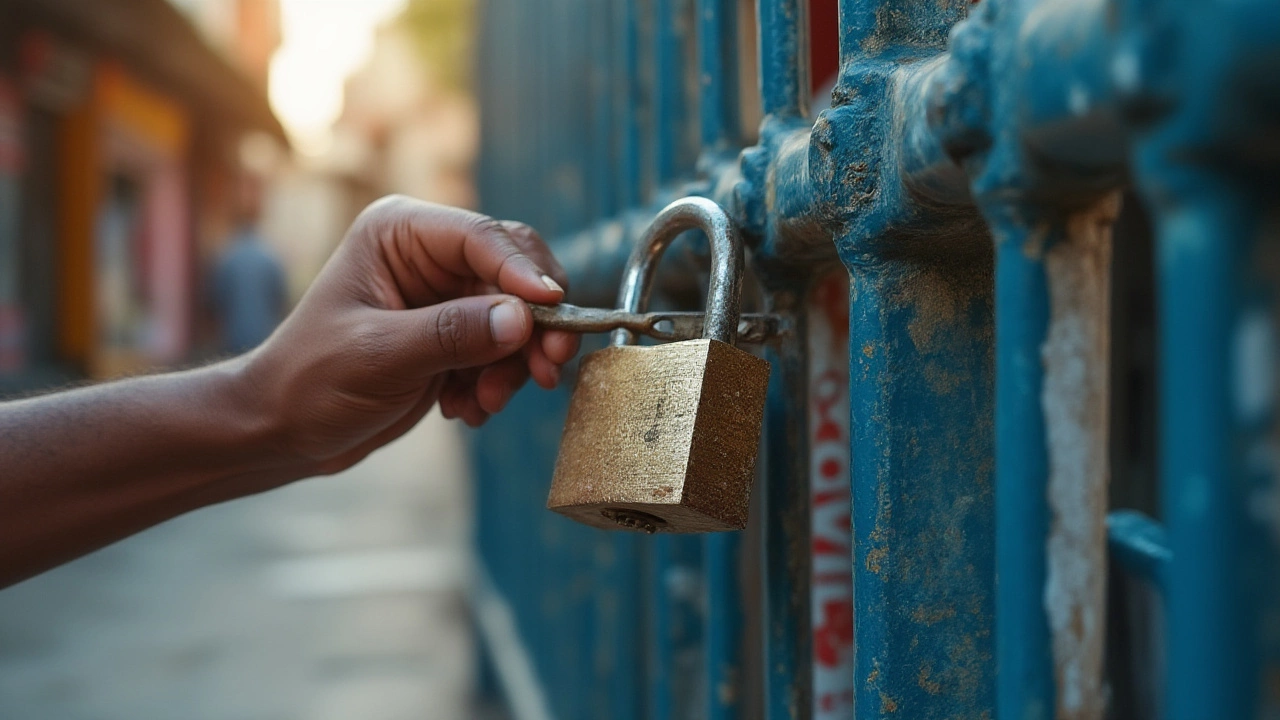If you’ve ever stood in front of your shed, gym locker, or backyard gate—keyless and annoyed—wondering if a locksmith can rescue your day, you’re not alone. Padlocks are everywhere, and losing the key, snapping it inside the lock, or dealing with a jam happens far more often than you’re told. Some people even think padlocks are invincible unless you have the exact key. The truth? Locksmiths break that myth daily, and the ways they do it combine skill, science, and a little bit of magic… or so it seems when you watch them work.
How Do Locksmiths Open Padlocks—Really?
Let’s bust the mystery: yes, a locksmith can open a padlock. And they don’t do it with brute force (unless you really want that lock broken). There are a few tried and tested methods, each chosen based on the type of padlock, its security level, and the situation. Locksmiths usually start with the least invasive trick—the one that saves your padlock and whatever it’s locking up.
The old-school way is picking. Padlocks have pins inside, like most house door locks. With the right tension wrench and pick, a locksmith will feel every pin click into place, unlocking the shackle quietly. It isn’t like the movies—nobody pops a padlock in seconds unless the lock is lousy or worn out. Picking a solid lock can take a pro a few minutes, especially on high-security models. Sometimes, locksmiths use raking, which is a faster, more brute-force picking, but this doesn’t work so well on locks with tricky pins.
If the lock’s design doesn’t allow for picking, or it’s a disk detainer padlock—super common for storage units and warehouses—locksmiths switch to other techniques. Bypassing is a favorite. If the mechanism can be triggered without dealing with the pins or disks, they’ll slide a tool inside and pop it open. It’s not as dramatic as it sounds, and it’s often possible because of design quirks or defects.
Then there’s decoding—for combination padlocks. Instead of spinning forever hoping for a miracle, locksmiths use special feeler tools or manipulation methods to “read” the code by sensing how the wheels catch. Some padlocks will give up their secrets quicker than others. The trickiest ones take more time and skill, but almost always, a specialist will get inside.
Finally, there’s the destructive route. Bolt cutters, angle grinders, and even hydraulic tools show up when a padlock is just too tough or if time is critical (think emergencies). This messes up the lock completely, but sometimes, it’s the only answer. Good locksmiths won’t go full-destruction unless there’s no other way.
Not every padlock falls in the same league. Here’s a quick table showing typical padlock types and locksmith methods:
| Padlock Type | Locksmith Method | Saves Lock? |
|---|---|---|
| Standard Pin Tumbler | Picking, Raking | Yes |
| Combination | Decoding, Manipulation | Yes |
| Disk Detainer | Picking, Bypassing | Yes |
| Hardened Steel | Cutting, Drilling | No |
| Weatherproof Marine | Picking, Drilling | Sometimes |
| Smart Padlock | Bypassing, Hacking | Rarely |
If you call a locksmith, expect questions about the padlock type, where it’s located, and if you want to save the lock. A decent pro will show up with a whole toolbox—lock picks, electric pick guns, mini grinders, special bypass gadgets, and sometimes some gear that looks like it belongs on a bomb squad. They’ll pick the right method so your property (and your nerves) survive the ordeal.
What Makes Some Padlocks Harder to Open?
So, why do some padlocks pop open under a minute, while others put up a major fight? It’s all in the build. The material, internal mechanism, anti-pick features, and the shackle’s thickness play a part. You might remember that $10 hardware store padlock you lost the key for—that’s the kind a locksmith could open with ease. But that chunky, heavy-duty lock on the storage unit, stamped "hardened" and weighing about as much as a small brick? Not so forgiving.
Budget padlocks usually rely on simple pin tumbler mechanisms. They might have just three pins, sometimes even plastic parts inside. Anyone with a basic lock pick kit and the patience to watch a two-minute online tutorial could probably get them open. Locksmiths breeze through these—the challenge isn’t the lock, it’s making sure the shackle doesn’t stick after years in the rain.
On the other hand, serious padlocks add security features like mushroom pins, which catch if you try to rake them quickly. Some locks pack anti-drill plates, ball bearings that jam up the mechanism with the tiniest slip, and steel inserts that blunt even the toughest drills. Disk detainer locks, the ones with a slot for a rotating key, can slow even the best tools. With these, locksmiths often reach for specialist tools—think of custom-made picks that cost more than the lock itself.
Combination locks usually aren’t as “safe” as they look. Low-end ones can be decoded with nothing more than a paperclip and some patience. But high-end combination padlocks tighten everything up. The tolerances get smaller, the feel for each wheel becomes a mind game, and locksmiths have to rely on years of experience to feel the right moment to click the shackle free.
Let’s not forget smart padlocks—the Bluetooth, fingerprint, or app-controlled models. Most aren’t as bulletproof as they claim. Some can be hacked or bypassed with covert electronics or a weak shackle that a simple tool can snap. But the newest ones, with encrypted communications and reinforced bodies, require both tech and muscle to break in.
Data from locksmith associations in the US show that more than 70% of padlock jobs involve simple mechanical locks—ones without a huge resistance to physical or picking attacks. But when it comes to high-security types, locksmiths spend longer and sometimes need to balance finesse with force. Here’s a rundown of common security features and how they stand up:
| Security Feature | What It Does | Effectiveness |
|---|---|---|
| Anti-Pick Pins | Catches picks or slows raking | Good |
| Anti-Drill Plates | Blunts and slows drilling attempts | Very Good |
| Shielded Shackle | Prevents bolt cutters | Excellent |
| Disc Detainer Mechanism | Pins replaced by rotating discs | Excellent |
| Hardened Steel Body | Resists sawing and cutting | Excellent |
| Smart Lock Encryption | Resists digital bypass | Fair to Good |
So, does high security equal unbreakable? Not quite. It means your lock buys you time and raises the cost for someone trying to defeat it—whether that’s a burglar… or your friendly neighborhood locksmith.

What Should You Do If You Lose Your Padlock Key?
The first urge might be to grab the nearest hammer or internet “life hack” video for picking a lock with two bobby pins. Slow down. Unless you want to destroy the lock or the thing it’s attached to, or stress yourself out even more, there are better options.
Start with a close look at the padlock. Some have serial numbers or make/model details. If you registered the lock or it came with a code card, you might be able to order new keys from the manufacturer without calling anyone. For simple locks, check for spare keys you stashed (check under flowerpots, toolboxes, or in those “clever” magnet boxes no one ever remembers until it’s too late).
If the lock is important, valuable, or on someone else’s property, don’t mess around—call a locksmith. Tell them exactly what kind of padlock you’re dealing with (a photo helps a lot), where it’s located, and if there’s any urgency. Do you need the lock intact, or is it okay to sacrifice it? Be clear—if you want it to look untouched, say so upfront.
Locksmiths might ask for proof that the lock is yours, especially if it’s on a gate, storage unit, or something old. It’s not about being nosy—it’s about making sure they aren’t helping the wrong person.
If you want to try some DIY (at your own risk and only on your property!), you can attempt some basic techniques:
- For combination padlocks, try default codes or common combinations (000, 123, 9999 on four-wheel locks).
- With old or cheap padlocks, gentle shimming (sliding thin metal inside the shackle gap) might work, but this often permanently damages the lock and rarely succeeds with modern types.
- Avoid force. Smashing a lock rarely ends well for what’s behind it and can attract unwanted attention or neighbors asking awkward questions.
The real world hack: consider upgrading your padlocks if losing keys is a regular thing. Some new models come with master dial reset codes, replaceable keys, or smart options that warn your phone if you leave them unlocked. But remember, the more tech you add, the more ways there are for things to go haywire. At the end of the day, the simplest fix is having a trusted locksmith’s number saved in your phone.
Extra Tips to Keep Your Things Safe—and Your Sanity
When you’re picking out a padlock, it’s tempting to grab the first one that “feels heavy” or “looks tough.” That’s not a guarantee it’ll keep your stuff safe, or that a locksmith will have an easy time if you ever need it opened. Here’s how to get the best out of your padlocks—and make life easier if things go sideways.
First off, always go for weatherproof if your lock’s going outdoors. Rusted pins are a nightmare—you might not even get the thing open with your own key, let alone anyone else. Lubricate padlocks once or twice a year with graphite, not oil (which just binds up dirt and makes it worse over time).
For anything valuable, stick to locks with at least five pins, anti-pick features, and a hardened shackle. If you’re locking up bikes or tools, try a disc detainer padlock or one with a shielded design. These are much tougher for both thieves and, yes, locksmiths—so weigh up convenience and security before you buy.
Keep a photo or record of your lock’s serial number. Store spare keys somewhere smart, or better yet, with a trusted friend or neighbor you can reach in a pinch. Avoid leaving keys on those obvious hooks just inside the door; you’d be shocked how often these disappear.
If you go the smart padlock route, read up on reviews and check if the app stays updated. Some brands have notorious issues with software glitches, leaving people locked out at the worst times.
If you ever need a locksmith, ask them about the unpickable lock myth—they’ll probably laugh. No lock is unpickable with enough time and the right technique. But you can make yours tough enough that they—and anyone else—think twice before taking it on.
One last fun fact: the world record for fastest padlock picking is just over half a second, but that was a simple design and a world champion. For real-world, quality padlocks, expect the best locksmiths to spend a few minutes, sometimes half an hour or more.
So, if you find yourself staring down a padlock with no key, don’t panic. Skilled pros—backed by real tools and lots of training—can open just about any padlock. Whether you want to save the lock or just get inside, they’ll have a method (or five). Just remember to pick your next padlock with care. You never know when you’ll have to call for backup.





Write a comment